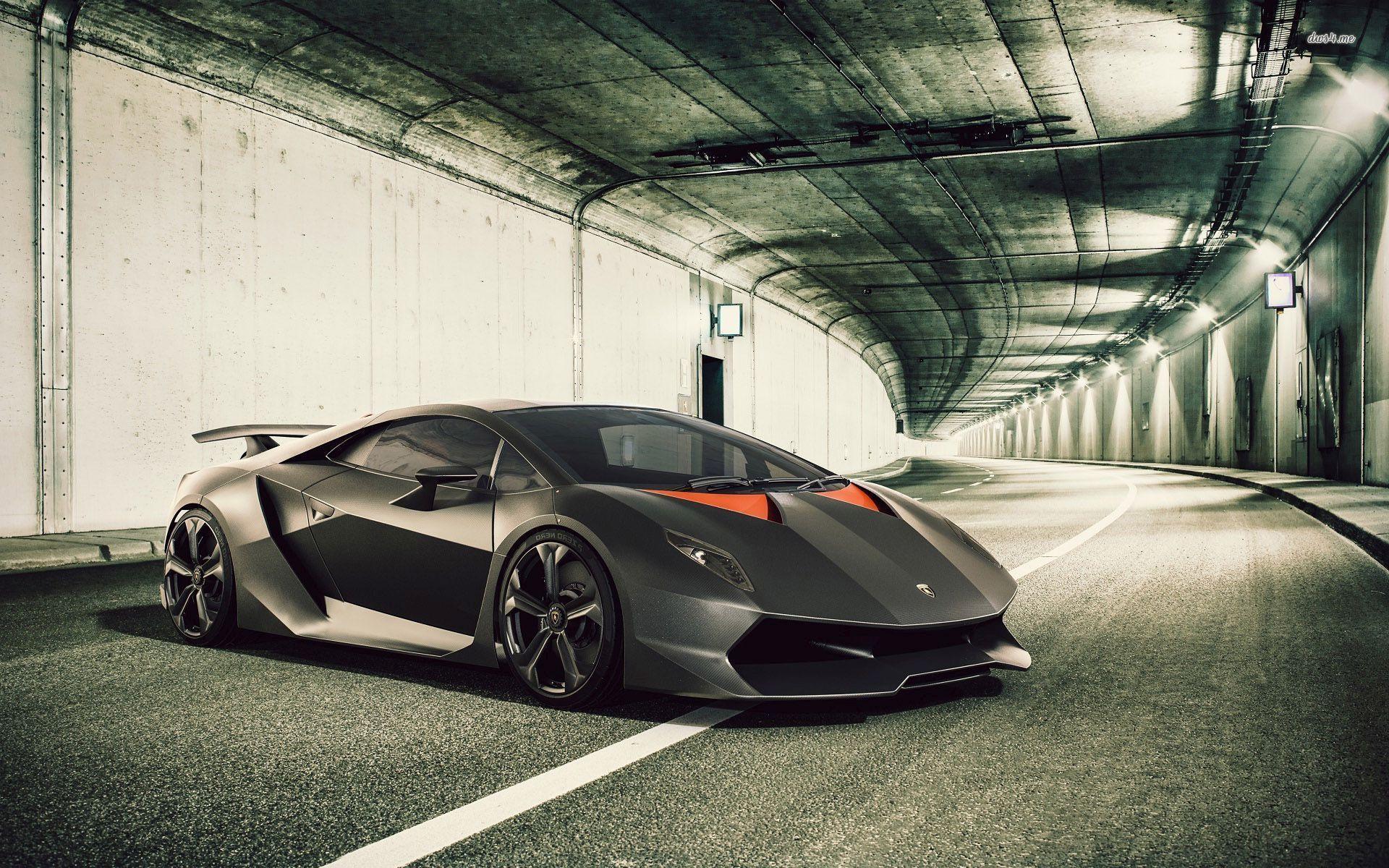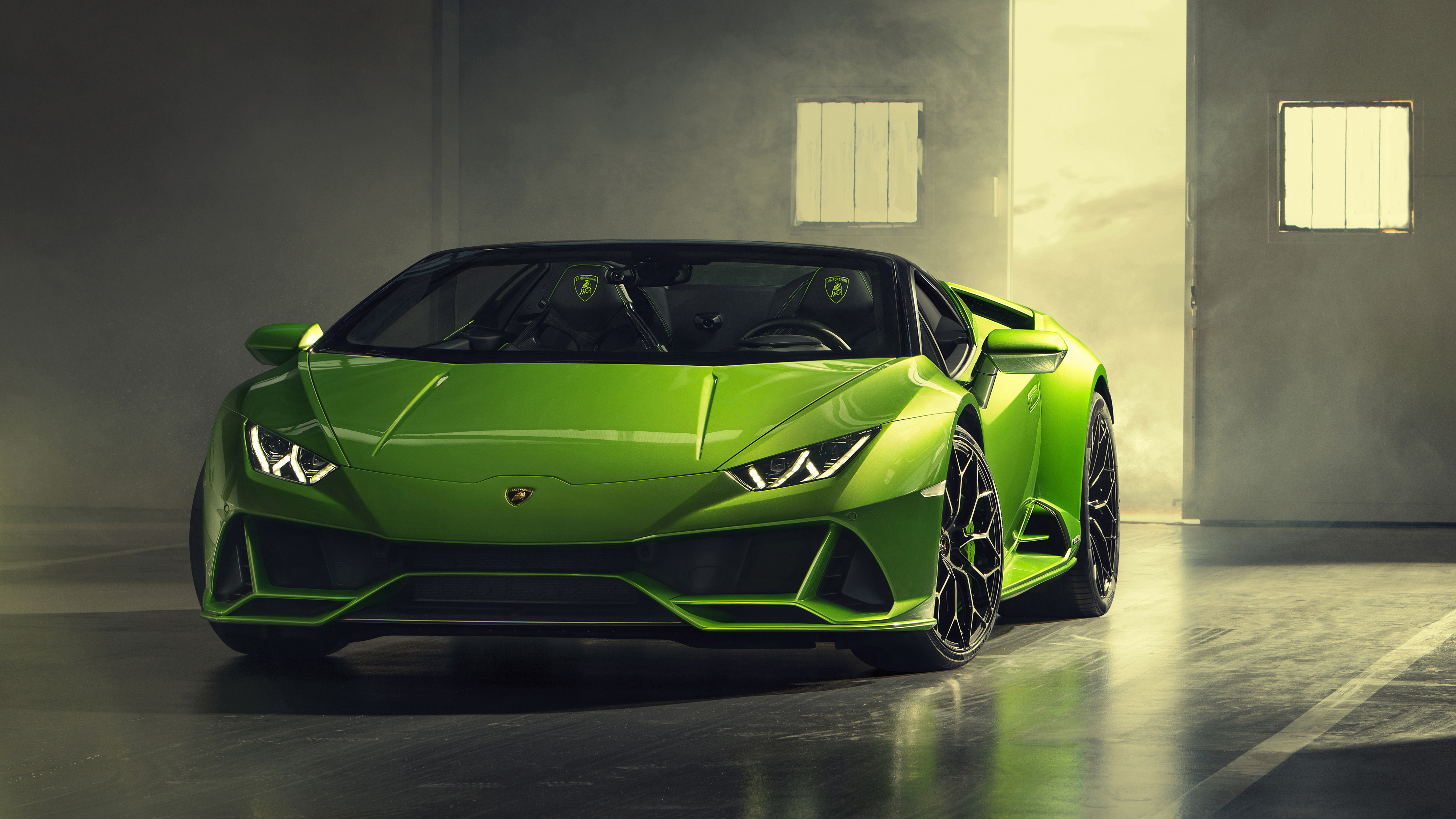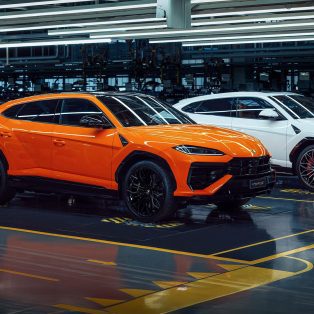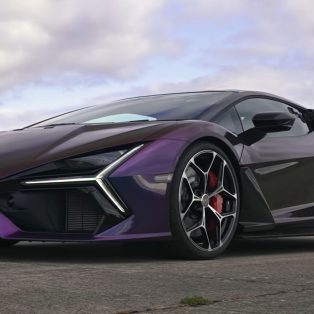We Compiled Lamborghini Performance Numbers & Specs for Every Lamborghini Ever Made. Horsepower, 0-60 mph time, 0-124 mph time, 1/4 Mile time & Top Speed
Fastest Top Speed
Fastest Accelerating
Fastest 1/4 Mile
Current Model Specs
Huracan
Aventador
Urus
Legacy Model Specs
350 GT
400 GT
Miura
Espada
Islero
Jarama
Urraco
Countach
Silhouette
Jalpa
LM002
Diablo
Murciélago
Gallardo
Few Offs Model Specs
Reventon
Sesto Elemento
Veneno
Centenario
Who would have thought that the owner of tractor company could start a car company that comes out of nowhere to build some of the fastest cars on the planet. Every Lamborghini from the beginning of the company’s history is fast relative to its peers from the same era whether that be Lamborghini’s first production car, the 350 GT or the current crop of supercars and SUV. When it comes to Lamborghini, you can expect 0-60 mph, 0- 100 mph and 1/4 mile times that are over with pretty bloody quickly.
Lamborghini is always upping the ante with every new model. We are talking about a car company that consistently delivers cars that launch from 0-60 mph in 3 seconds flat or under. The current Lamborghini Huracan Evo and Aventador ranges all have 2.9 second 0-60 mph times and hit 100 mph in the 9 second range.
It really started with the Miura and the Countach, both cars that were meaningfully faster and more aggressive than other competitors. It cemented Lamborghini’s place at the top of the supercar ladder. It was the addition of all-wheel drive the Diablo VT in 1993 when things really got quick in terms of Lamborghini 0-60 mph and 1/4 mile times, the added traction making the Diablo bolt off the line with no wasted horsepower. From then onwards all Lamborghini cars have been defined as acceleration monsters. Murcielago, Gallardo, Huracan, Aventador – all blindingly fast.
When were putting this list together we asked you guys what you wanted to see in a fastest Lamborghinis post. While lap times and top speed numbers were important, most of you wanted to see Lamborghini 0 – 60 mph and quarter miles times. There is just something about a car going from standstill to sixty mph that gets car guys talking, it is the bread and butter of car enthusiast arguments and has been for decades. You can feel a Lamborghini 0-60 mph time and even quarter mile in a way that you can’t with top speed. Any modern Lamborghini will hit 200 mph and you can do that speed exactly nowhere. Hit 60 mph in under 3 seconds in a Lamborghini, you can do that anywhere you want, anytime you want. Plus, most top speeds are electronically limited (usually to protect tires) so it is an artificial number. In saying that, enough people wanted the Lamborghini top speed numbers so we included them.
In this post you will find Lamborghini 0-60 mph, 0-100 mph times and 1/4 mile times for every production Lamborghini ever. We also added horsepower numbers and top speed numbers for every Lamborghini model to round out the performance elements we believe made most sense to compare. We focused on production model performance and chose not include any of the concept cars or the pure race cars.
Our approach was to go through our Lamborghini model list to find the acceleration times published by Lamborghini directly and where we couldn’t find them we sourced from third party testing. We sorted the results a few different ways. First by fastest accelerating, fastest top speed, fastest quarter mile and then we broke them out by model too. Hopefully that works for you guys but let us know if it doesn’t.
More Lamborghini: Lamborghini Hub, Model List, Current Lineup, Model Specs, News & Reviews
Updated July 2019: Added Lamborghini Urus and Huracan Evo
Fastest Lamborghini Cars
Fastest Lamborghini by Top Speed
With a top speed of 221 mph, the Lamborghini Veneno and Veneno Roadster take top honors as the fastest Lamborghini’s in the world. They are followed by the epic Sesto Elemento that cracks a 220 mph top speed. After that we have ten Lamborghini supercars that each hit 217 mph top speeds. Most of the cars on this list would in fact do much more if they were allowed too (blame electronically limited top speeds). All of the models are based on the Aventador engine and chassis so while each would in fact hit a higher speed if freed from an electronic nanny, we would expect them to all be within a whisker of each other anyway.
| Model | Top Speed |
|---|---|
| Lamborghini Veneno | 221 mph |
| Lamborghini Veneno Roadster | 221 mph |
| Lamborghini Sesto Elemento | 220 mph |
| Lamborghini Aventador LP700-4 | 217 mph |
| Lamborghini Aventador LP700-4 Roadster | 217 mph |
| Lamborghini Aventador LP750-4 SV | 217 mph |
| Lamborghini Aventador LP750-4 SV Roadster | 217 mph |
| Lamborghini Aventador S | 217 mph |
| Lamborghini Aventador S Roadster | 217 mph |
| Lamborghini Aventador SVJ | 217 mph |
| Lamborghini Aventador SVJ Roadster | 217 mph |
| Lamborghini Centenario | 217 mph |
| Lamborghini Centenario Roadster | 217 mph |
Fastest Lamborghini (0-60 mph & 0-124 mph)
All Lamborghinis are fast in a straight line but recent models have gotten crazy fast in terms of sheer acceleration. It is no surprise that the fastest accelerating Lamborghini ever is the experimental Sesto Elemento with its advanced body and no compromises approach to performance. 0 – 60 mph is over in 2.5 seconds and it also decimates the 0 – 124 mph in 8 seconds flat, more than half a second faster than the second fastest accelerating Lamborghini, the Aventador SVJ.
This list of the fastest 0 – 60 mph and 0 – 124 mph Lamborghinis is again dominated by Aventador based special edition cars like the Veneno, Centenario and SVJ (in coupe and roadster form). The top ten is rounded out by the new Huracan Evo and the Huracan Performante, both of which cost at least half as much as any of the other cars on the list. Both are able to hit 60 mph in under 3 seconds and hit 124 mph in under 9 seconds, easily keeping it close with their more expensive and exotic siblings.
| Model | 0-60 mph (seconds) | 0-124 mph (seconds) |
|---|---|---|
| Lamborghini Sesto Elemento | 2.5 sec | 8.0 sec |
| Lamborghini Aventador SVJ | 2.5 sec | 8.6 sec |
| Lamborghini Aventador SVJ Roadster | 2.5 sec | 8.6 sec |
| Lamborghini Veneno | 2.8 sec | 8.9 sec |
| Lamborghini Veneno Roadster | 2.8 sec | 8.9 sec |
| Lamborghini Aventador LP750-4 SV | 2.8 sec | 8.6 sec |
| Lamborghini Aventador LP750-4 SV Roadster | 2.8 sec | 8.8 sec |
| Lamborghini Centenario | 2.8 sec | – |
| Lamborghini Aventador LP700-4 | 2.9 sec | 8.9 sec |
| Lamborghini Aventador S | 2.9 sec | 8.7 sec |
| Lamborghini Centenario Roadster | 2.9 sec | – |
| Lamborghini Huracán Evo | 2.9 sec | 9.0 sec |
| Lamborghini Huracan Performante | 2.9 sec | 8.9 sec |
Fastest Lamborghini over a 1/4 Mile Distance
The fact that the ten fastest Lamborghini’s over a 1/4 mile are all under 10.4 seconds is astounding. Such is the recent pace of innovation in the supercar world that you can walk into a dealership and put down some money for a Huracan Evo and walk away with a 10.4 second car. You would need to pay a little more to get your hands on a Performante or Performante Spyder so you could do it in as little as 10.2 seconds.
| Model | 1/4 Mile Time (seconds) |
|---|---|
| Lamborghini Huracan Performante | 10.2 sec |
| Lamborghini Huracan Performante Spyder | 10.2 sec |
| Lamborghini Aventador SVJ | 10.3 sec |
| Lamborghini Aventador SVJ Roadster | 10.3 sec |
| Lamborghini Veneno | 10.3 sec |
| Lamborghini Veneno Roadster | 10.3 sec |
| Lamborghini Huracán Evo | 10.3 sec |
| Lamborghini Sesto Elemento | 10.4 sec |
| Lamborghini Aventador LP750-4 SV Roadster | 10.4 sec |
| Lamborghini Huracán Evo Spyder | 10.4 sec |
List Of Lamborghini Performance Numbers For Current Models
Lamborghini Huracan: Power, 0-60 MPH, 0-124 Mph, 1/4 Mile & Top Speed
In 2014 Lamborghini officially launched the Huracán, the successor to the Gallardo. The Huracán got 610 bhp V10 and gorgeous body and was immediately a sales success. Thanks to that engine and all wheel drive, acceleration wise it was an absolutely monster. It went from standstill to 60 mph in a tad over 3 seconds and hit 124 mph in just under 10 seconds. The real-wheel drive models followed and had a little less power and as a result were slower. They made up for their straight-line deficit against the all wheel drive models with sweeter handling.
The best Lamborghini made ever in terms of sheer driving dynamics was the Huracan Performante and Huracan Performante Spider. The Performante got more power (+29 hp) and less weight (- 90 lbs), suspension improvements, and the addition of an innovative aerodynamic package. 0-60 mph is over in just 2.9 and 0- 124 mph in only 8.9. Seriously fast, focused and exciting. With its naturally aspirated engine and all the changes coming together, this is a supercar that is immersive and addictive.
The Huracán EVO is the mid-life update for the Huracan platform. Lamborghini did lots of fine tuning, tweaking and improving to make the already great Huracan better. On the outside the Evo gets design changes that add some drama to the Huracan. On the inside the Evo has a new state-of-the-art control system and innovative touch screen easily manage the car’s functions and entertainment system. The V10 now produces 631bhp and 442 lb/ft of torque. That means a power-to-weight ratio of 451 bhp per tonne, good for a top speed of 202, and zero to 62mph in 2.9 seconds.
| Model | Power | 0-60 mph | 0-124 mph | Top Speed | 1/4 Mile |
|---|---|---|---|---|---|
| Lamborghini Huracan Coupe (610-4) | 610 bhp | 3.2 sec | 9.9 sec | 202 mph | 10.5 sec |
| Lamborghini Huracan Spyder (610-4) | 610 bhp | 3.2 sec | 9.9 sec | 201 mph | 10.8 sec |
| Lamborghini Huracán RWD | 571 hp | 3.4 sec | 10.1 sec | 199 mph | 11.2 sec |
| Lamborghini Huracán RWD Spyder | 571 hp | 3.6 sec | 10.4 sec | 199 mph | 11.5 sec |
| Lamborghini Huracan Performante | 631 hp | 2.9 sec | 8.9 sec | 201 mph | 10.2 sec |
| Lamborghini Huracan Performante Spyder | 631 hp | 3.1 sec | 9.3 sec | 201 mph | 10.2 sec |
| Lamborghini Huracán Evo | 631 hp | 2.9 sec | 9.0 sec | 202 mph | 10.3 sec |
| Lamborghini Huracán Evo Spyder | 631 hp | 3.1 sec | 9.3 sec | 202 mph | 10.4 sec |
Lamborghini Aventador: Power, 0-60 MPH, 0-124 Mph, 1/4 Mile & Top Speed
The Aventador has been Lamborghini’s top supercar model range since 2011. It started with the Aventador LP 700-4 that ran through 2016 and as expected it was one of the quickest straight line performers in the world with sub-3 second 0-60 mph times and top speed electronically limited to 217 mph. The platform was updated in 2016 and runs through today’s current model range (known by 740-4) or otherwise known as the Aventador S range. The current Aventador range is made up of two main cars, the Aventador S (both coupe and roadster) and the Aventador SVJ (both coupe and roadster). The S is the base model while the SVJ is the extreme model.
The updated entry level Aventador is now known as the Aventador S. It still has a mid-engined naturally aspirated 6.5 liter V12 engine with 730 horsepower and 509 lb/ft of torque. Roadster is a fire breathing supercar with 730hp from a naturally aspirated V12. The Aventador SVJ is the wildest Lamborghini we have seen in years. It set a new Nürburgring Nordschleife record for production cars, running an incredible 6:44.97 lap time. Its 6.5-liter V12 produces 760 horsepower and 531 lb-ft of torque. A host of upgrades over the base model including less weight to haul around transform the driving experience.
| Model | Power | 0-60 mph | 0-124 mph | Top Speed | 1/4 Mile |
|---|---|---|---|---|---|
| Lamborghini Aventador LP700-4 | 690 bhp | 2.9 sec | 8.9 sec | 217 mph | 10.5 sec |
| Lamborghini Aventador LP700-4 Roadster | 690 bhp | 3.0 sec | 9.0 sec | 217 mph | 10.8 sec |
| Lamborghini Aventador LP750-4 SV | 750 hp | 2.8 sec | 8.6 sec | 217 mph | 10.5 sec |
| Lamborghini Aventador LP750-4 SV Roadster | 750 hp | 2.8 sec | 8.8 sec | 217 mph | 10.4 sec |
| Lamborghini Aventador S | 750 hp | 2.9 sec | 8.7 sec | 217 mph | 10.5 sec |
| Lamborghini Aventador S Roadster | 750 hp | 3.0 sec | 8.9 sec | 217 mph | 10.7 sec |
| Lamborghini Aventador SVJ | 760 hp | 2.5 sec | 8.6 sec | 217 mph | 10.3 sec |
| Lamborghini Aventador SVJ Roadster | 760 hp | 2.5 sec | 8.6 sec | 217 mph | 10.3 sec |
Lamborghini Urus: Power, 0-60 MPH, 0-124 Mph, 1/4 Mile & Top Speed
Lamborghini calls the Urus the world’s first Super Sport Utility Vehicle. We call it a luxurious, sporty SUV where outlandish performance meets comfort and versatility. It offers best-in-class driving dynamics and is easily the best performing SUV on the planet. The Lamborghini Urus is anything but your typical people hauler. The first *modern* Lamborghini SUV and one hell of an SUV.
The Urus looks aggressive and has the right level of Lambo styling without going overboard. The Urus is power by a 4.0 liter twin-turbo V8 that is good for 641 horsepower and 627 lb/ft of torque. Performance is astonishing for a big SUV, with 0-60 mph over in 3.2 seconds and a top speed of 190 mph. The Urus drives better than any other SUV and is definitely the performance pick in that segment. On the inside the Urus has decent luggage space and more electronics and infotainment equipment.
| Model | Power | 0-60 mph | 0-124 mph | Top Speed | 1/4 Mile |
|---|---|---|---|---|---|
| Lamborghini Urus | 641 bhp | 3.2 sec | 11.7 sec | 190 mph | 11.3 sec |
List Of Lamborghini Performance Numbers For Legacy Models
Lamborghini 350 GT: Power, 0-60 MPH, 0-100 Mph, 1/4 Mile & Top Speed
This is where it all began. The 350 GTV prototype definitely got potential customers excited so Lamborghini decided to produce production cars as a result. The 350 GT introduced a more balanced design than the aggressive 350 GTV. The production version had four-wheel independent suspension, a quad-cam V12 with a Scaglione-designed, aluminum body. Solid orders for the car ensured the companies’ survival and paved the way for future models.
| Model | Power | 0-60 mph | 0-100 mph | Top Speed | 1/4 Mile |
|---|---|---|---|---|---|
| Lamborghini 350 GT | 270 bhp | 7.4 sec | 17.8 sec | 155 mph | 15.5 sec |
| Lamborghini 350 GTS | 320 bhp | 7.4 sec | 17.8 sec | 155 mph | 15.5 sec |
| Lamborghini 350 GTV (concept) | 360 hp | – | – | 174 mph | – |
| Lamborghini 3500 GTZ (concept) | 320 hp | – | – | 162 mph | – |
Lamborghini 400 GT: Power, 0-60 MPH, 0-100 Mph, 1/4 Mile & Top Speed
Lamborghini launched the first 400 GT in 1966 and was an updated version of the 350 GT with a bigger and much more powerful V12 engine. The engineers at Lamborghini increased the stroke from 77 to 82 for a total displacement of 3929cc. This brought over power from 270 to 320 bhp at 6500 rpm. The 400 GT was restyled and made roomier vs its predecessor. The 400 GT 2+2 was an even more updated model that accommodated a rear set of seats that couldn’t fit in the original design.
| Model | Power | 0-60 mph | 0-100 mph | Top Speed | 1/4 Mile |
|---|---|---|---|---|---|
| Lamborghini 400 GT | 320 bhp | 7.4 sec | 17.8 sec | 155 mph | 15.5 sec |
| Lamborghini 400 GT 2+2 | 320 bhp | 7.4 sec | 17.8 sec | 155 mph | 15.5 sec |
| Lamborghini 400 GT Monza | 320 bhp | – | – | – | – |
| Lamborghini 4000 GT ‘Flying Star II’ | 320 bhp | 7.4 sec | 17.8 sec | 155 mph | 15.5 sec |
Lamborghini Miura: Power, 0-60 MPH, 0-100 Mph, 1/4 Mile & Top Speed
Very few cars managed to change the automobile world like the Miura. It was the first true supercar. It had a radical specification in relation to common engineering of the time. The Miura was endowed with a quad-cam V12 that sat transverse and behind the drivers. Immediately, everything from Ferrari to Aston Martin looked outdated by comparison upon release. It redefined the concept of a sports car. Over time, upgrades and small details were changed, but a huge update called the SV was the pinnacle of the Miura range. The main focus of the SV was a new rear suspension that made the car much wider plus longer wishbones were fitted that added 1.5 inches of length. You will notice that straight line speed was actually down versus the Miura S because the SV was all about the driving experience being improved (and it was).
| Model | Power | 0-60 mph | 0-100 mph | Top Speed | 1/4 Mile |
|---|---|---|---|---|---|
| Lamborghini Miura | 350 bhp | 6.3 sec | 14.3 sec | 163 mph | 14.5 sec |
| Lamborghini Miura S | 370 bhp | 5.5 sec | 12.3 sec | 168 mph | 13.9 sec |
| Lamborghini Miura SV | 385 bhp | 5.75 sec | – | 155 mph | 14.3 sec |
| Lamborghini Miura SVJ (one-off) | 440 bhp | 3.6 sec | – | – | – |
Lamborghini Espada: Power, 0-60 MPH, 0-100 Mph, 1/4 Mile & Top Speed
The Lamborghini Espada was unveiled at the 1968 Geneva Auto Show, after Ferruccio Lamborghini demanded the creation of a proper four-seater. During its ten-year production, the Espada received several modifications. While the engine and the interior were changed with each series, the design of the bodywork remained almost untouched. The Espada became Lamborghini’s bestseller from 1968 to 1978.
| Model | Power | 0-60 mph | 0-100 mph | Top Speed | 1/4 Mile |
|---|---|---|---|---|---|
| Lamborghini Espada (Series I) | 330 bhp | 7.8 sec | – | 152 mph | 15.0 sec |
| Lamborghini Espada (Series II) | 345 bhp | 6.6 sec | – | 155 mph | – |
| Lamborghini Espada (Series III) | 345 bhp | 6.6 sec | – | 161 mph | – |
Lamborghini Islero: Power, 0-60 MPH, 0-100 Mph, 1/4 Mile & Top Speed
The Lamborghini Islero was the replacement for the Lamborghini 400GT. The 2+2 Coupè immediately highlighted Lamborghini’s expertise in terms of engine output, chassis, and overall performance. Production ceased after only 225 units. The car debuted at the 1968 Geneva Auto Show. The 340 bhp, 3.9L DOHC V-12 engine had six Weber carburetors, a five-speed manual transmission and four-wheel independent suspension.
In 1969, Lamborghini improved the 2+2 with a more powerful 350 bhp V12 engine and upgrades to the mechanics, aesthetics and interior. The Islero S was a much better car than the 400 GTS.
| Model | Power | 0-60 mph | 0-100 mph | Top Speed | 1/4 Mile |
|---|---|---|---|---|---|
| Lamborghini Islero | 320 bhp | 6.2 sec | – | 165 mph | – |
| Lamborghini Islero S | 350 bhp | 6.1 sec | – | 165 mph | – |
Lamborghini Jarama: Power, 0-60 MPH, 0-100 Mph, 1/4 Mile & Top Speed
Think of the Lamborghini Jarama as a Lamborghini Islero version 2.o. It had a shorter chassis to meet U.S. standards (the main reason it was commissioned in the first place), shortened by almost 11 inches. Thanks to the excellent combination of a strong engine and luxurious comfort it was one of the founders favorite cars. The original GT had a V12 with 350 bhp and was followed by the GTS that had 365 bhp.
| Model | Power | 0-60 mph | 0-100 mph | Top Speed | 1/4 Mile |
|---|---|---|---|---|---|
| Lamborghini Jarama GT | 350 bhp | 7.2 sec | 17.7 sec | 152 mph | 15.6 sec |
| Lamborghini Jarama S | 365 bhp | 6.8 sec | 15.5 sec | 161 mph | – |
Lamborghini Urraco: Power, 0-60 MPH, 0-100 Mph, 1/4 Mile & Top Speed
Thank the oil crisis of the ’70s for the Urraco. It forced Lamborghini to build a car with a smaller engine that had better emissions. At the same time Lamborghini was trying to grow its buyer base and those prospective buyers wanted a four seater that was more luxurious and comfortable. The Urraco was the first Lamborghini V8 engine with a displacement starting at 2.5 liters and later growing to 3 liters. The P111 was developed for the U.S market. The P200 Urraco became available for the Italian market in response to 17% additional taxes levied against cars with engines larger than 2 liters. The P300 was the pick of the bunch, much improved over the P250 and with a larger 3 liter engine and 247 hp.
| Model | Power | 0-60 mph | 0-100 mph | Top Speed | 1/4 Mile |
|---|---|---|---|---|---|
| Lamborghini Urraco P200 | 180 bhp | 7.2 sec | – | 134 mph | – |
| Lamborghini Urraco P111 | 180 bhp | 7.2 sec | – | 140 mph | – |
| Lamborghini Urraco P250 | 217 bhp | 6.9 sec | – | 149 mph | – |
| Lamborghini Urraco P300 | 247 bhp | 5.6 sec | – | 162 mph | – |
Lamborghini Countach: Power, 0-60 MPH, 0-100 Mph, 1/4 Mile & Top Speed
Its mid-mounted four-cam V12 engine and low, sleek, dramatic styling set a new standard for an Italian supercar. It was so unconventional, aggressive and futuristic that is cemented Lamborghini’s position as the coolest maker of supercars on the planet. The first Countach generation was named LP 400. Its 4 liter V12 engine was mounted lengthwise and produced 375 hp and 266 ft/lbs of torque. The Lamborghini Countach LP400S was an update, with more aggressive look (new spoilers) was a result of adding the widest tires available. The Lamborghini Countach LP5000S fulfilled the initial goal of getting a 5-liter engine into the Countach and it made a difference, power was up 50 hp compared to the 4 liter engine.
Lamborghini’s third major Countach revision came in 1985 at the Geneva Show. The model was named after its new cylinder head which featured four valves per cylinder (it was known either as the Quattrovalvole or QV). The 25th Anniversary was the last and most aggressive Countach. Taking the 5000S further it had redesigned aero ducts and a redesigned front and rear kevlar hoods. The chassis was upgraded extensively too.
| Model | Power | 0-60 mph | 0-100 mph | Top Speed | 1/4 Mile |
|---|---|---|---|---|---|
| Lamborghini Countach LP400 | 325 bhp | 6.8 sec | 13.1 sec | 181 mph | 14.4 sec |
| Lamborghini Countach LP400S | 325 bhp | 5.9 sec | 12.9 sec | 181 mph | 14.3 sec |
| Lamborghini Countach LP5000S QV | 455 bhp | 5.2 sec | 10.9 sec | 182 mph | 13.7 sec |
| Lamborghini Countach LP5000S | 375 bhp | 5.6 sec | 12.8 sec | 186 mph | 13.9 sec |
| Lamborghini Countach 25th Anniv | 455 bhp | 4.8 sec | 10.6 sec | 190 mph | 13.2 sec |
Lamborghini Silhouette: Power, 0-60 MPH, 0-100 Mph, 1/4 Mile & Top Speed
Known as the Silhouette P300, the mid-engined Silhouette was the based on the Lamborghini Urraco. Only 53 units were built. It came at a time of desperation for the company who was struggling to survive. Ferruccio asked Bertone to redesign the Urraco P300 into a different looking car that would boost sales. It was comfortable and got several upgrades with solid acceleration across the first 100 mph.
| Model | Power | 0-60 mph | 0-100 mph | Top Speed | 1/4 Mile |
|---|---|---|---|---|---|
| Lamborghini Silhouette | 260 bhp | 6.8 sec | 16.1 sec | 147 mph | 15.2 sec |
Lamborghini Jalpa: Power, 0-60 MPH, 0-100 Mph, 1/4 Mile & Top Speed
Known as the Lamborghini Jalpa P350, it was a natural evolution of the Silhouette and the final attempt at creating an entry level Lamborghini with a V8 engine. Power increased and handling was markedly better than the Silhouette while the body was again a new design crafted by Bertone. Performance as to be expected was better than its predecessor, particularly from 0 – 60 mph.
| Model | Power | 0-60 mph | 0-100 mph | Top Speed | 1/4 Mile |
|---|---|---|---|---|---|
| Lamborghini Jalpa | 255 bhp | 6.0 sec | 16.1 sec | 145 mph | 16.1 sec |
Lamborghini LM002: Power, 0-60 MPH, 0-124 Mph, 1/4 Mile & Top Speed
Butish Lamborghini LM002 was a part military, part SUV, part maniac and 100% awesome. The “Rambo-Lambo” had four-wheel drive, seating for four, and more than enough room for luggage. It had a large V12 that was good for 450 hp. Despite the big powerplant the LM002 was a heavy beast so 0-60 mph acceleration and top speed performance were not super exciting.
| Model | Power | 0-60 mph | 0-100 mph | Top Speed | 1/4 Mile |
|---|---|---|---|---|---|
| Lamborghini LM002 | 450 bhp | 7.7 sec | – | 130 mph | – |
Lamborghini Diablo: Power, 0-60 MPH, 0-100 Mph, 1/4 Mile & Top Speed
The main goal for the Diablo was a top speed of at least 315 kmh (196 mph) and Lamborghini beat it, with the initial Diablo hitting 202 mph. The Diablo did it with a 5.7 liter V-12 engine with four valves per cylinder and 485 horsepower. This new supercar was wide, low, and futuristic. The Diablo VT came in 1993 as an update and for the first time the Diablo got wheel drive with a viscous center diff to improve traction. 0-60 mph time dropped by almost half a second and the quarter mile time also came down by two tenths of a second. To celebrate Lamborghini’s 30th year as a road car maker, a special edition Diablo called the SE30 was offered in 1993. It was the fastest car Lamborghini had made: 207 mph flat out and 0-60 in 4 seconds.
The SV version of the Diablo was a 2WD version that also befitted from the 30 Edition Jota upgrades and a light drivetrain. A few years later the Diablo received a mid-cycle facelift in 1999. They simplified the model range by eliminating the “base” Diablo (SV became the new entry-level). The second generation VT coupé received the same cosmetic and mechanical upgrades as the SV model, including the open headlamps, restyled interior, 529 hp V12 engine, and ABS. In 1999, fans were surprised when the Diablo GT was revealed at the Geneva Motor Show. It combined the modifications of the GT2 race car with the craziness of the Diablo to offer serious road racing performance.
The final Diablo update was the Diablo VT 6.0 which was the result of Audi starting to influence Lamborghini. A major development of the original design, not only on the outside but also on the inside and the underpinnings of the Diablo led to a better overall car and some serious performance improvements, particularly over the 1/4 mile.
| Model | Power | 0-60 mph | 0-100 mph | Top Speed | 1/4 Mile |
|---|---|---|---|---|---|
| Lamborghini Diablo | 485 bhp | 4.5 sec | 10.8 sec | 202 mph | 13.3 sec |
| Lamborghini Diablo VT | 492 bhp | 4.1 sec | – | 204 mph | 13.0 sec |
| Lamborghini Diablo SE30 | 525 bhp | 4.0 sec | 9.3 sec | 207 mph | – |
| Lamborghini Diablo SE30 Jota | 595 bhp | 4.0 sec | – | 207 mph | – |
| Lamborghini Diablo VT Roadster | 492 bhp | 4.0 sec | – | 203 mph | – |
| Lamborghini Diablo SV | 510 bhp | 3.8 sec | 9.3 sec | 207 mph | – |
| Lamborghini Diablo VT (Facelift) | 529 bhp | 3.95 sec | – | 210 mph | – |
| Lamborghini Diablo VT Roadster (Facelift) | 529 bhp | 3.95 sec | – | 208 mph | – |
| Lamborghini Diablo SV (Facelift) | 529 bhp | 3.85 sec | – | 210 mph | – |
| Lamborghini Diablo GT | 575 bhp | 3.6 sec | 8.5 sec | 215 mph | 12 sec |
| Lamborghini Diablo VT Roadster Millennium | 529 bhp | 3.9 sec | – | 208 mph | – |
| Lamborghini Diablo VT (6.0) | 550 bhp | 3.9 sec | 8.9 sec | 205 mph | 11.9 sec |
| Lamborghini Diablo VT (6.0) SE | 550 bhp | 3.8 sec | 8.9 sec | 205 mph | 12.0 sec |
Lamborghini Murciélago: Power, 0-60 MPH, 0-100 Mph, 1/4 Mile & Top Speed
Lamborghini next supercar was the mighty Murciélago. It had a mid-mount V12 engine, permanent 4WD with a central viscous coupling. The 6.2 liter V12 engine an evolution of the Diablo 6.0 power plant, the main upgrades being two new variable systems. Featuring the unmistakable Lamborghini styling, it was a real performer, with 0 – 60 mph in under four seconds and a top speed over 200 mph. The Roadster followed soon after the coupe and was just a devastating in a straight line.
The next step in the Murciélago evolution was the LP640 model. A larger front spoiler and new rear mirrors were part of the minor cosmetic changes. The engine in the LP640 had undergone radical modification and there was a big jump on horsepower from 580 hp to 640 hp. 0 – 60 mph and 0 – 100 mph times dropped by almost half a second and a full second respectively. The Lamborghini Murcielago LP640 Roadster benefited from the same extensive modifications to the bodywork and mechanics as the LP640 Coupé.
Think of the Murciélago LP 670-4 SuperVeloce as even more powerful, lighter and faster Murciélago LP 640. With the output of the 6.5 liter V12 increased to 670 hp and a weight reduction of 220 lbs it is a beast and was our favorite Murcielago. The Roadster version had 6.5 litre V12 engine that produces 650 hp along with permanent four-wheel drive. The special edition model (50 units only) combines grey bodywork with a special bright orange offset.
| Model | Power | 0-60 mph | 0-100 mph | Top Speed | 1/4 Mile |
|---|---|---|---|---|---|
| Lamborghini Murciélago (Initial Version) | 577 bhp | 3.8 sec | 8.6 sec | 210 mph | 11.7 sec |
| Lamborghini Murciélago Roadster | 580 bhp | 3.8 sec | 8.6 sec | 205 mph | 11.7 sec |
| Lamborghini Murciélago LP 640 | 640 bhp | 3.3 sec | 7.5 sec | 211 mph | 11.5 sec |
| Lamborghini Murciélago LP640 Roadster | 640 bhp | 3.4 sec | 8.1 sec | 205 mph | 11.8 sec |
| Lamborghini Murciélago LP650–4 Roadster | 650 bhp | 3.3 sec | – | 205 mph | – |
| Lamborghini Murciélago LP 670–4 SV | 670 bhp | 3.2 sec | 7.0 sec | 212 mph | 11.0 sec |
Lamborghini Gallardo: Power, 0-60 MPH, 0-100 Mph, 1/4 Mile & Top Speed
The Gallardo is the best selling Lamborghini ever. It entry level Lambo was powerful, dynamic and a true Lamborghini in every way. Powered by a Lamborghini V10 that had a 90 degree angle and dry sump to allow it to sit lower in the chassis. Lamborghini’s entry level car was fast from day one, but Lamborghini quickly followed its release with the Gallardo SE, a limited to 250 units with shorter gear ratios for better acceleration. Two years after the release of the Gallardo Coupe, Lamborghini released their drop-top version. Beyond no top, the Spyder a number important modifications to the original engine and transmission. Next up was the Gallardo Superleggera with increased power (an additional 10 hp) and a 100 kg reduction in weight, it ramped up straight line performance and hit 60 mph from standstill almost a half second faster than the coupe.
The Gallardo LP 560-4 was a wholesale update of the Gallardo platform with a new engine, permanent four-wheel drive transmission and new suspension. It improved performance and dynamics a lot. Power was up to almost 560 hp and zero to 60 mph was over an a scant 3.6 sec while the run to 100 mph was over in under eight seconds. Even more dynamic, lighter, more powerful and stunning was the Lamborghini Gallardo LP 570-4 Superleggera. It is 155 pounds lighter than the regular car and it gets an extra 10 hp. More of a driver’s car and once again it was much faster across the performance spectrum.
Notable was the Lamborghini Gallardo LP550-2, a rear wheel drive version of the Gallardo. A little slower, but much better fun to drive. The final version of the Gallardo was a final year production model that had several updates over the LP560-4. It looked even more aggressive, and more extreme. Lots of triangular and trapezoidal forms in the design.
| Model | Power | 0-60 mph | 0-100 mph | Top Speed | 1/4 Mile |
|---|---|---|---|---|---|
| Lamborghini Gallardo | 493 bhp | 4.2 sec | 9.0 sec | 192 mph | 12.2 sec |
| Gallardo SE | 500 bhp | 4.0 sec | 8.7 sec | 196 mph | 12.1 sec |
| Gallardo Spyder | 520 bhp | 4.2 sec | 9.0 sec | 195 mph | 12.2 sec |
| Gallardo Superleggera | 530 bhp | 3.8 sec | 8.6 sec | 196 mph | 11.7 sec |
| Gallardo LP 560-4 | 552.5 bhp | 3.6 sec | 6.9 sec | 202 mph | 11.2 sec |
| Gallardo LP 560-4 Spyder | 552.5 bhp | 3.9 sec | 7.0 sec | 201 mph | 11.5 sec |
| Gallardo LP 550-2 | 550 bhp | 3.7 sec | 7.6 sec | 199 mph | 11.6 sec |
| Gallardo LP 570-4 Superleggera | 562 bhp | 3.3 sec | 6.8 sec | 202 mph | 11.0 sec |
| Gallardo LP 550-2 Spyder | 550 bhp | 3.7 sec | 7.6 sec | 198 mph | 11.6 sec |
| Gallardo LP 570-4 Spyder Performante | 562 bhp | 3.3 sec | – | 201 mph | – |
| Gallardo LP560-4 (Update) | 560 bhp | 3.6 sec | 6.9 sec | 202 mph | 11.2 sec |
| Gallardo LP560-4 Spyder (Update) | 560 bhp | 3.9 sec | – | 201 mph | 11.8 sec |
List Of Lamborghini Performance Numbers For Few Offs Specials
Lamborghini Reventon: Power, 0-60 MPH, 0-124 Mph, 1/4 Mile & Top Speed
The Reventon is the most outrageous Lamborghini and some say the styling has gone to far. But that’s fine since a limited production of only 20 examples will be made. The Reventon is a strong mix of acute and obtuse angles that mimic the Murcielago lines in a whole new and more frantic way. We loved it and its 641 horsepower engine. Acceleration was epically quick at 0 – 60 mph in 3.3 seconds and onto a top speed of 205 mph.
| Model | Power | 0-60 mph | 0-124 mph | Top Speed | 1/4 Mile |
|---|---|---|---|---|---|
| Lamborghini Reventon | 641 bhp | 3.3 sec | – | 205 mph | – |
Lamborghini Sesto Elemento: Power, 0-60 MPH, 0-124 Mph, 1/4 Mile & Top Speed
The Sesto Elemento was a masterpiece of extreme lightweight engineering that showed that Lamborghini could do some amazing things with the carbon-fiber technology. The 2,202 lb carbon fiber car was a revelation. V10 power unit and the permanent all-wheel drive in a body so light meant it had an insanely high power-to-weight ratio.
| Model | Power | 0-60 mph | 0-124 mph | Top Speed | 1/4 Mile |
|---|---|---|---|---|---|
| Lamborghini Sesto Elemento | 562 bhp | 2.5 sec | 8 sec | 220 mph | 10.4 sec |
Lamborghini Veneno: Power, 0-60 MPH, 0-124 Mph, 1/4 Mile & Top Speed
Only three unique units of the Lamborghini Veneno were built and sold. Its design is consistently focused on optimum aerodynamics and cornering stability, giving the Veneno the real dynamic experience of a racing prototype, yet it is fully homologated for the road. It gets 750 hp and 0 to 60 mph in just 2.8 seconds. In 2014 Lamborghini announced the Veneno Roadster with a production run of just nine units and a price tag of $4.5 million. The engine is a development of the Aventador 6.5-litre V12 and generates a power output of 740 hp at 8,400 rpm and 509 lb⋅ft of torque at 5,500 rpm.
| Model | Power | 0-60 mph | 0-124 mph | Top Speed | 1/4 Mile |
|---|---|---|---|---|---|
| Lamborghini Veneno | 740 bhp | 2.8 sec | 8.9 sec | 221 mph | 10.3 sec |
| Lamborghini Veneno Roadster | 740 bhp | 2.8 sec | 8.9 sec | 221 mph | 10.3 sec |
Lamborghini Centenario: Power, 0-60 MPH, 0-124 Mph, 1/4 Mile & Top Speed
The new Lamborghini Centenario represents a new, extremely precious piece in Lamborghini’s one-off strategy. It is a tribute to the 100th anniversary of the birth of Mr. Ferruccio Lamborghini. A total of 20 Coupes and Roadsters will be made.
| Model | Power | 0-60 mph | 0-124 mph | Top Speed | 1/4 Mile |
|---|---|---|---|---|---|
| Lamborghini Centenario | 759 bhp | 2.8 sec | – | 217 mph | – |
| Lamborghini Centenario Roadster | 759 bhp | 2.9 sec | – | 217 mph | – |


















